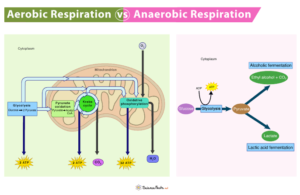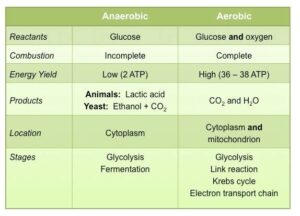Back to: Botany 400 Level
Hello, my amazing Afrilearn scholar! Welcome back! I hope you’re ready for another exciting and informative lesson. Today, we’ll be looking at two different ways that plants (and all living organisms) produce energy: aerobic respiration and anaerobic respiration. You’ve already learned about cellular respiration, but did you know that cells can perform it in different ways depending on the presence of oxygen? By the end of this lesson, you’ll understand the key differences between aerobic and anaerobic respiration, how they work, and why they’re important for plant growth and survival. Let’s get started!
Aerobic vs. anaerobic respiration
Have you ever noticed that sometimes you can run around for a long time without getting too tired, but other times, you run out of breath more quickly? This is because your body (and plant cells!) uses two types of processes to produce energy, depending on the conditions. Just like you might need more oxygen when you’re running, plants need oxygen for aerobic respiration. But what happens if oxygen is not available? That’s when anaerobic respiration comes into play! Today, we’ll take a closer look at both processes, their differences, and how they help living things survive.

Aerobic Respiration
Let’s start with aerobic respiration. This is the process that happens when oxygen is present. It’s the most efficient way for cells to make energy because oxygen helps the cell produce a lot of ATP (the energy currency of the cell).
How it works:
Glycolysis happens first (just like in all types of respiration), where glucose is broken down into pyruvate.
The pyruvate is then transported to the mitochondria, where the Krebs Cycle and Electron Transport Chain take place.
During the Krebs Cycle, energy is harvested, and oxygen is used in the Electron Transport Chain to produce lots of ATP.
The by-products of this process are carbon dioxide (CO₂) and water (H₂O), which are then released as waste.
Why it’s important:
Aerobic respiration produces a lot of ATP, which is used by the plant for growth, reproduction, and other vital functions. This process is much more efficient than anaerobic respiration.
Example:
Think of aerobic respiration as a big power plant that uses plenty of fuel (glucose) and oxygen to produce a large amount of electricity (ATP). It’s a steady, efficient process that provides the cell with enough energy to do its work.
Anaerobic Respiration
Now, let’s talk about anaerobic respiration, which happens when oxygen is not available. It’s a way for cells to still make energy, but it’s much less efficient.
How it works:
Just like in aerobic respiration, glycolysis happens first and glucose is broken down into pyruvate.
However, instead of going to the mitochondria for further breakdown, the pyruvate undergoes a different process that doesn’t require oxygen.
In plants, the pyruvate is converted into ethanol (alcohol) and carbon dioxide (CO₂). This process doesn’t produce nearly as much ATP as aerobic respiration.
Example:
Imagine you’re trying to power a small lamp but only have a tiny battery and no connection to a power source. The small battery can still make the lamp work, but it doesn’t give you nearly as much power as plugging it into the mains electricity (which is like oxygen-powered respiration). That’s the difference between anaerobic and aerobic respiration!

Why it’s important:
Anaerobic respiration is helpful when there’s no oxygen available, like in waterlogged soil or during a quick burst of energy. However, it produces far less ATP, so it’s not ideal for long-term energy production.
Let’s think about a situation where you’re working hard. If you’re exercising, for example, when you can breathe in plenty of air (oxygen), you can work for longer without feeling tired. This is like aerobic respiration. But, if you’re sprinting really hard and can’t catch your breath (no oxygen), your body switches to a less efficient form of energy production, like anaerobic respiration. In the same way, plants in waterlogged soil or areas without oxygen might use anaerobic respiration to make some energy, but they won’t be able to produce as much as they would with oxygen.
Summary
Aerobic respiration requires oxygen and produces a lot of ATP, carbon dioxide, and water as by-products. It’s the most efficient form of energy production for plants and other living organisms.
Anaerobic respiration doesn’t require oxygen, but it produces much less ATP and by-products like ethanol and carbon dioxide. It’s useful when oxygen is unavailable, but it’s not as efficient as aerobic respiration.
Evaluation
- What is the key difference between aerobic and anaerobic respiration?
- What are the by-products of anaerobic respiration in plants?
- Why is aerobic respiration considered more efficient than anaerobic respiration?
- Can you think of a situation where plants might use anaerobic respiration?
You’ve made great progress today by understanding the differences between aerobic and anaerobic respiration. Remember, both types of respiration are important for energy production, but oxygen gives the plant more energy to grow and thrive. Keep up the great work, and I can’t wait to see you in the next lesson. You’re on the right track—keep shining!
